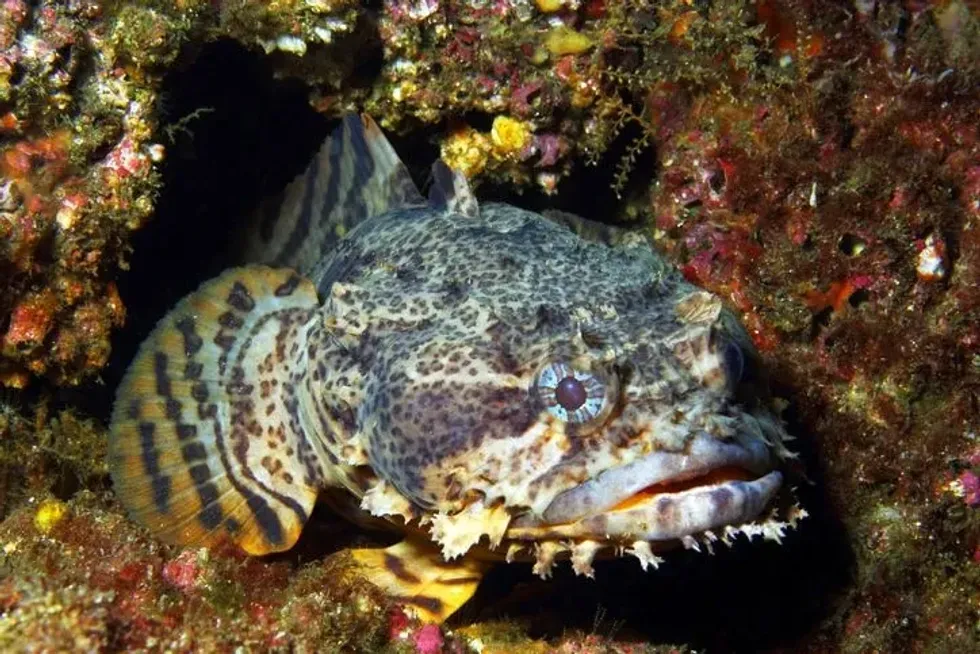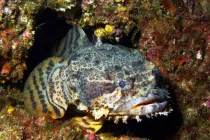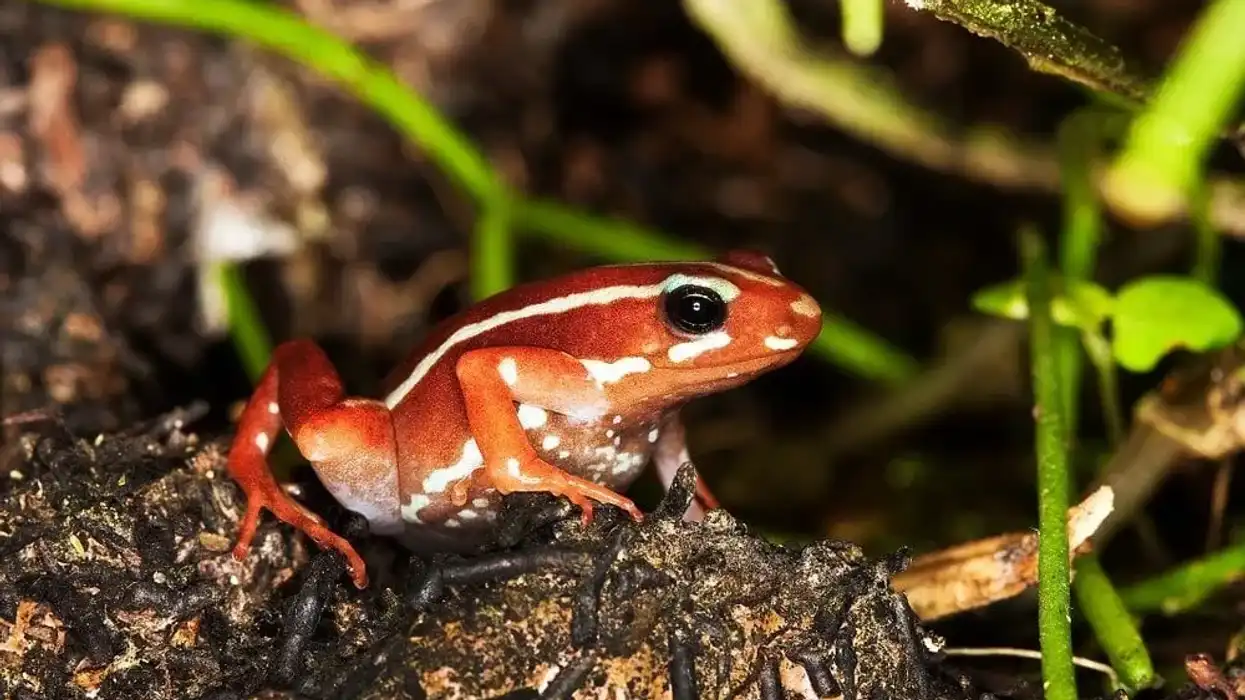The marine water ecosystem houses many strange creatures. One of these strange-looking creatures is the oyster toadfish (Opsanus tau). The oyster toadfish looks like a toad and is quite ugly.
Their habitat is the muddy bottoms of the ocean, especially near oyster reefs. As a species, they are quite large and common, too. They have the specialty to stay in littered water as well.
They can make their nest in tin cans, too. The olive-brown fish is known for its resilience, flesh flaps around its mouth and jaws, and its toad-like large head.
If caught, they can be cooked. The length of this fish is admirable, too. They can be found living in the western Atlantic region.
Their blunt teeth may not seem harmful, but they can snap their mouth, which can deliver quite some force. They are generally deep-water fish. Read on for more information about this strange fish.
If you like this article, you may also like John Dory and ribbon eel.
Oyster Toadfish Interesting Facts
What type of animal is an oyster toadfish?
The oyster toadfish (Opsanus tau) is a kind of fish. They are also known as the bar dog, ugly toad, oyster cracker, and other names.
What class of animal does an oyster toadfish belong to?
The oyster toadfish (Opsanus tau) belongs to the class Actinopterygii.
How many oyster toadfish are there in the world?
Oyster toadfish are quite common in water ecosystems around the world, and there is not much information regarding the specific number of oyster toadfishes.
Where does an oyster toadfish live?
Oyster toadfish generally like to inhabit oyster reefs. They can be found mostly in the United States. They are found in the West Atlantic near the US, like the Chesapeake Bay and the Gulf of Maine.
What is an oyster toadfish's habitat?
Oyster toadfish can be found in the marine neritic region or the shallow regions of the ocean. They live near the coastal regions and estuarine waters, generally near reefs and wrecks. This makes them more adaptive towards pollution and litter.
Who do oyster toadfish live with?
Generally, toadfish tend to live solitary lives.
How long does an oyster toadfish live?
Known as the ugly toad, oyster cracker, and other names, the lifespan of oyster toadfish is around 5-8 years in the ocean water.
How do they reproduce?
The oyster toadfish use mating calls to initiate their courtship process. This is a loud mating call that can be heard in the distance, too. The female lays eggs, and the male tends to protect those eggs from any predators.
The male is also responsible for keeping the nest neat. Both the male and the female tend to reach their sexual maturity in their second year. Spawning generally occurs between June and July.
What is their conservation status?
As per the IUCN, oyster toadfish is under the Least Concern status. The population seems to be currently stable.
Oyster Toadfish Fun Facts
What do oyster toadfish look like?

Oyster toadfishes have a flat body, and their body has no scales. Another reason why they are seen as ugly is because of their scaleless body, which is covered with warts and mucus.
They seem to have whispers on their jaw and cheeks, which are flaps of flesh. These fishes have a large head, which appears to be like a toad, and their teeth are blunt, but they had strong jaws. The head can help you distinguish them if they get caught in front of you.
How cute are they?
Oyster toadfish are not cute. They have big eyes that bulge outwards, a big toad-like head with flesh flaps hanging from their jaws. They also have mucus and warts covering their body making them quite gross.
How do they communicate?
Toadfishes can be quite vocal when they communicate. The males tend to court the female with a loud call which has been referred to as a 'foghorn call'. They can also use vocal cues through grunts or long growls when they are afraid or annoyed.
How big is an oyster toadfish?
The oyster toadfish is around 12 in. This is quite small when we compare it with the codfish standing at a length of 78 in.
How fast can an oyster toadfish swim?
The oyster toadfish has an average speed of 141.7-330.7 inches per minute.
How much does an oyster toadfish weigh?
An oyster toadfish does not weigh a lot. It weighs around 3-5 lb.
What are their male and female names of the species?
There are no specific male or female names of this species.
What would you call a baby oyster toadfish?
A baby oyster toadfish is referred to as a fry since they are a fish.
What do they eat?
The oyster toadfish is a carnivore. Their diet generally consists of crabs, hermit crabs, amphipods, squid, shrimp, worms, and oysters. They have strong teeth that snap. They also love feeding on xanthid crabs and mud crabs.
Do they bite?
When out of the water, the oyster toadfish can snap. An oyster toadfish bite can hurt a lot.
Would they make a good pet?
Oyster toadfish are bottom-dwellers and require marine habitat. They are not cute either. Hence, it is not really advisable to keep them as pets.
Did you know...
Back in 1998, NASA sent an oyster toadfish in space to understand the effects of microgravity on the human balance system as the oyster toadfish balance mechanism is similar to humans.
Google searches like 'oyster toadfish edible' and 'oyster toadfish poisonous' are quite popular.
They do not have scales and are covered with mucus so that they can camouflage easily.
Can you eat oyster toadfish?
Most anglers don't eat oyster toadfish since they look ugly. However, it can be eaten. It is said that their meat is dense and firm.
The oyster toadfish's mating and breeding
Male oyster toadfish, when they are ready to spawn, use a foghorn or boat signal-like call, which can be heard underwater from a long distance. This foghorn call is used to indicate that the male had found a place for spawning.
The female hears the call and lays eggs in that area. The male now protects the eggs and also keeps fanning the eggs until they hatch.
Even after the eggs hatch, the male looks after the young ones for 3-4 weeks. The male continues to protect the young ones even after they become free-swimmers.
Here at Kidadl, we have carefully created lots of interesting family-friendly animal facts for everyone to discover! Learn more about some other fish including bony fish, or candiru.
You can even occupy yourself at home by drawing one on our Oyster Toadfish coloring pages.










